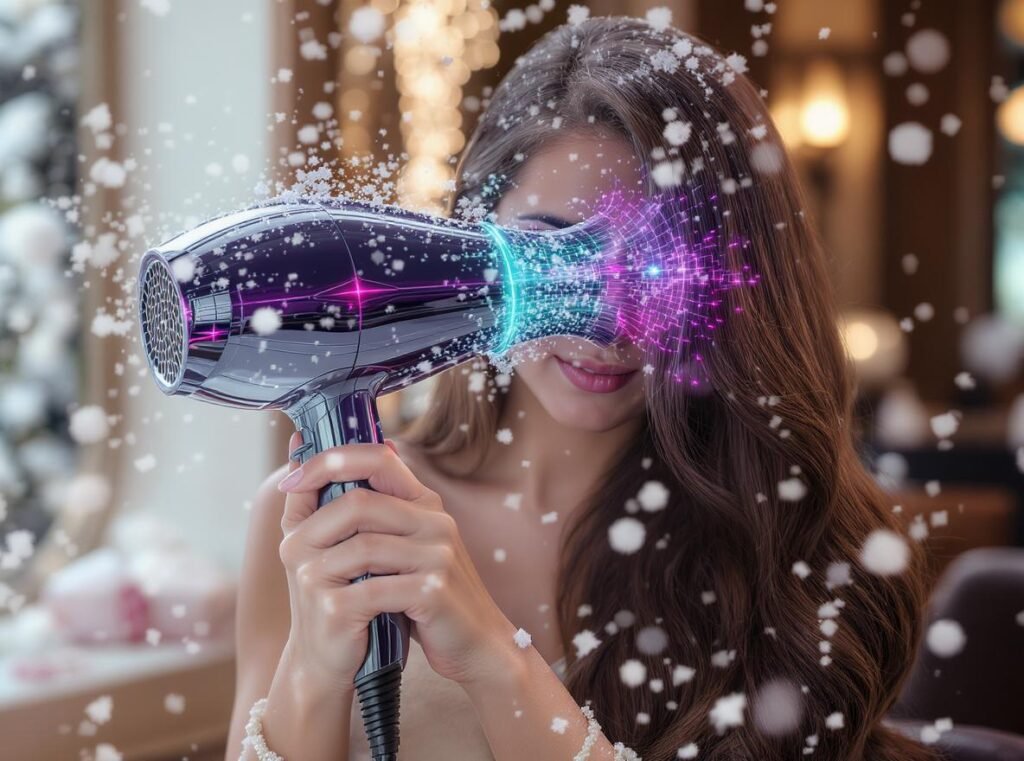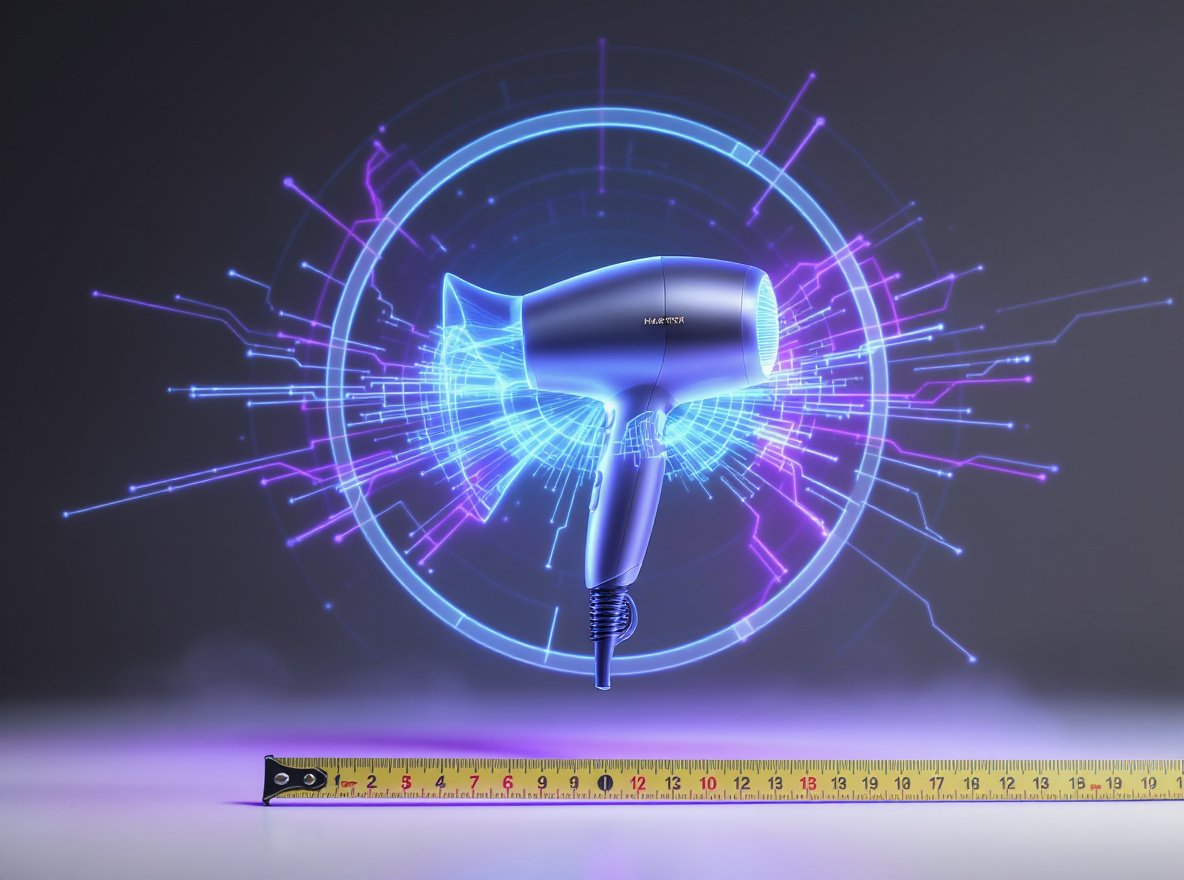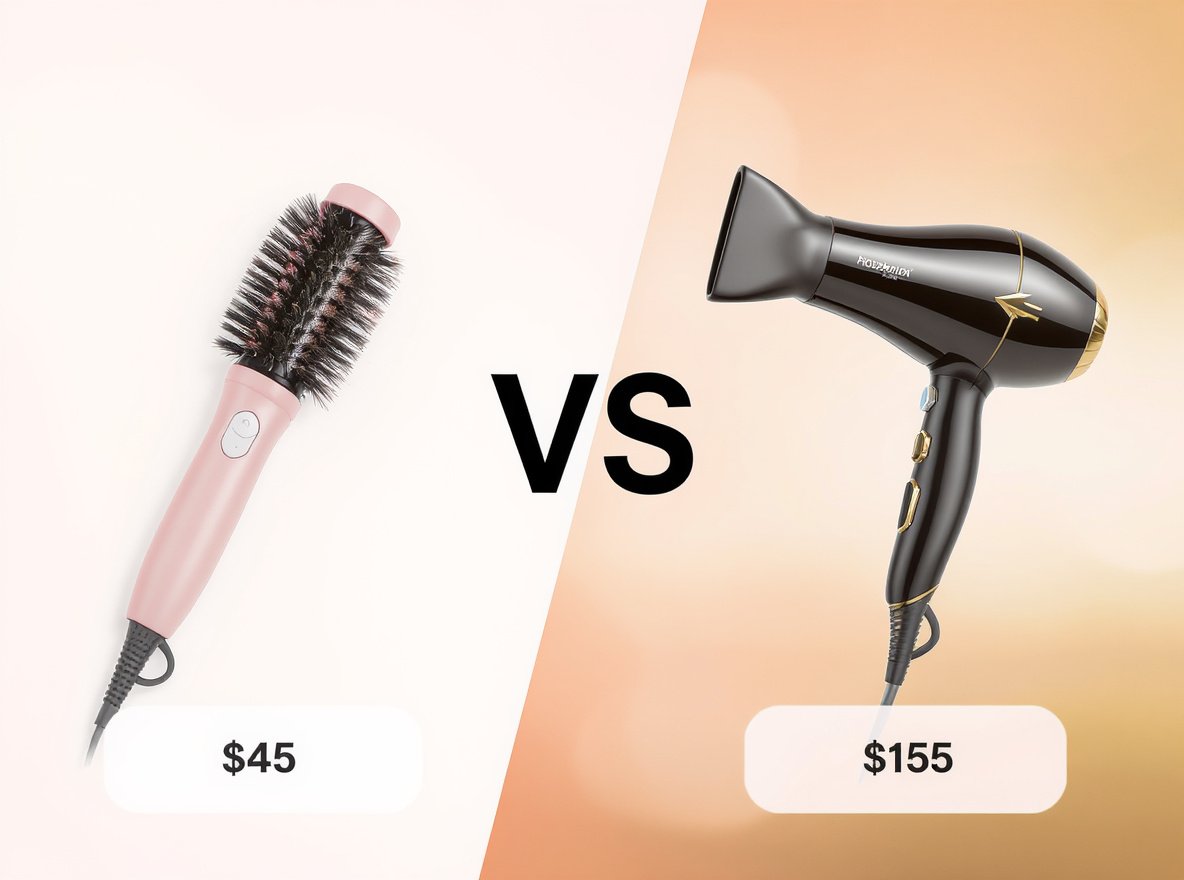Winter weather wreaks havoc on your hair through multiple environmental assaults. Cold outdoor air and heated indoor environments strip natural moisture, while low humidity creates static electricity that leads to frizz and flyaways. Your hair becomes more fragile, prone to breakage, and loses its natural volume and shine during these harsh months.
The best hair dryers for winter hair care are ionic and ceramic models with adjustable heat settings, cool shot functions, and advanced technologies. High-speed dryers with negative ion generation, like the Conason P1C, effectively reduce drying time while minimizing heat damage and static buildup that winter weather exacerbates.
Let’s explore the essential features and technologies that make certain hair dryers superior for winter hair protection.
Table of Contents
ToggleWhat Makes Winter Hair Care So Challenging?
Winter creates a perfect storm of environmental factors that simultaneously attack your hair’s health and appearance from multiple angles.
Winter hair challenges stem from dryness and dehydration caused by cold outdoor air and heated indoor environments, combined with increased static electricity from low humidity and friction from winter accessories.
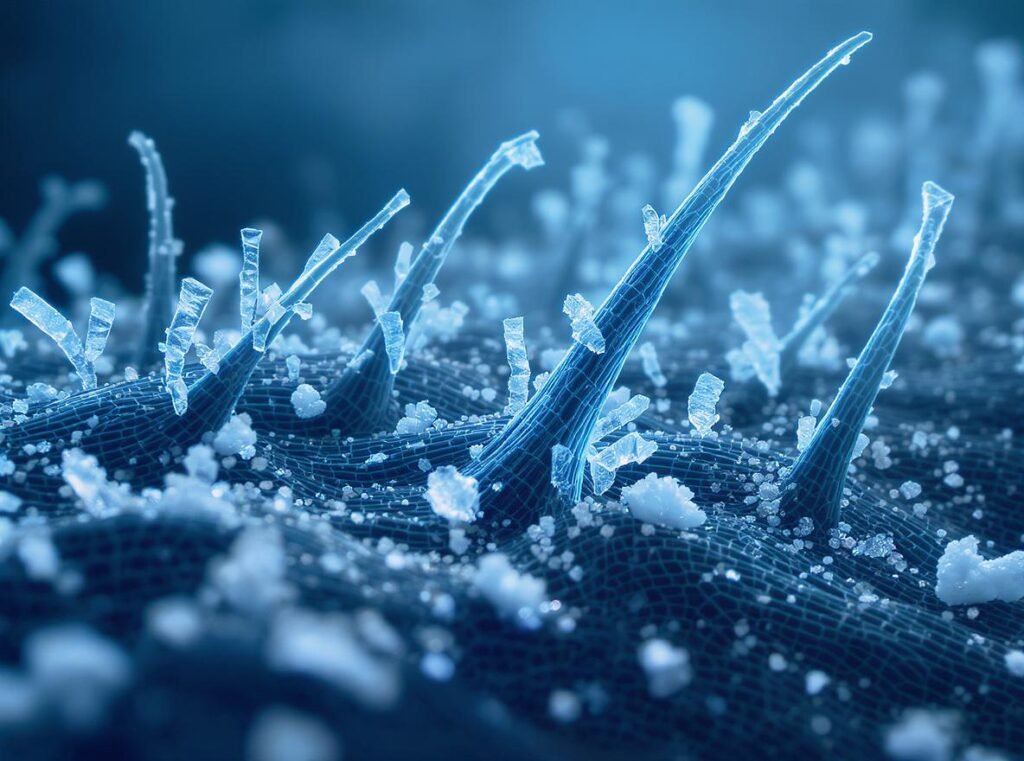
Cold air outside and heated air inside strip hair of natural moisture, leading to dryness, brittleness, and breakage. The dramatic temperature differences between outdoor and indoor environments create a constant cycle of expansion and contraction in your hair shaft, increasing porosity and moisture loss.
Low humidity levels, often dropping below 30% in heated indoor spaces, increase static electricity. This problem is compounded by friction from hats, scarves, and winter clothing, causing frizz and flyaways that are difficult to control.
Additional winter hair challenges include:
- Hair tends to lose volume and look lifeless due to lack of moisture
- Increased fragility makes hair more prone to split ends and damage
- Winter accessories weigh down hair, contributing to flat, limp appearance
- Scalp issues can develop from prolonged dampness when hair doesn’t dry properly
Understanding these challenges helps you choose the right hair dryer technology to combat winter’s harsh effects.
Why Do Hair Dryers Matter More in Winter?
Your hair dryer becomes your most important styling tool during winter months when environmental factors make proper drying crucial for hair health.
Hair dryers matter more in winter because they provide faster drying to prevent prolonged dampness, help lock in moisture, and offer advanced technologies that minimize static and frizz common in cold weather.
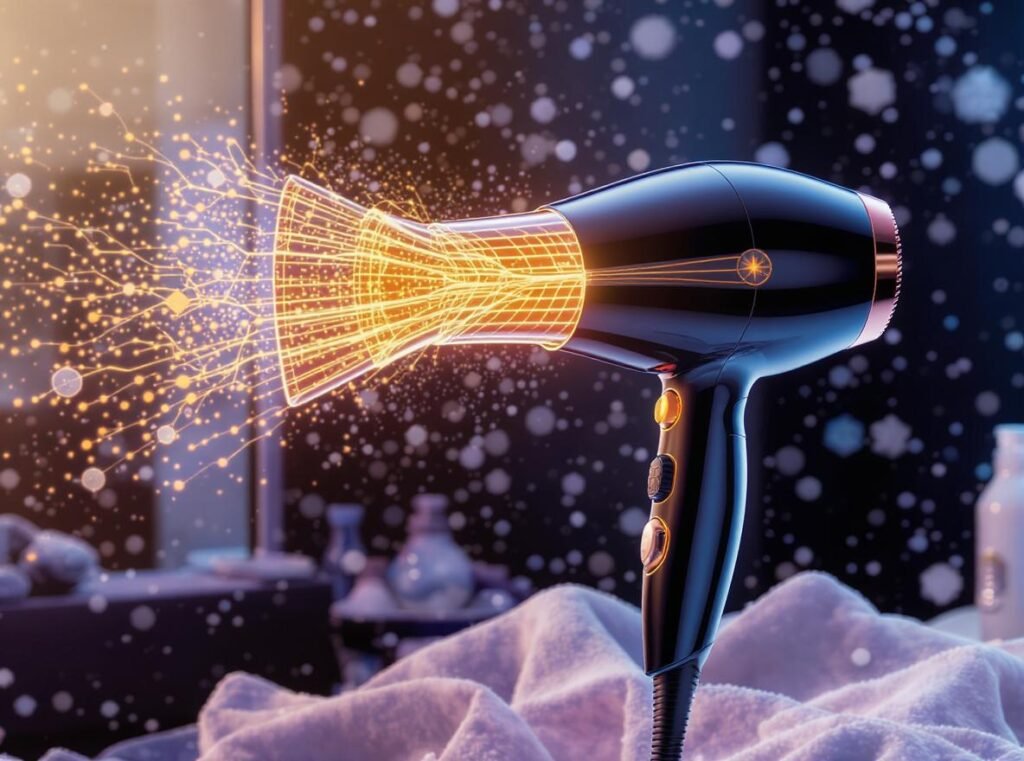
Air-drying in cold weather can leave hair damp for hours, significantly increasing the risk of breakage and scalp issues. When hair remains wet for extended periods in cold temperatures, the hair shaft becomes more vulnerable to damage and breakage.
The right hair dryer technology can actually help counteract winter’s drying effects. Advanced dryers with ionic or infrared technology help minimize static and frizz while sealing moisture into the hair shaft during the drying process.
Key Winter Benefits:
- Faster drying reduces time hair is exposed to environmental damage
- Moisture retention technology helps preserve natural hydration
- Static control features eliminate winter’s most frustrating hair problems
- Temperature control prevents additional heat damage to already-compromised hair
Professional-grade dryers become especially valuable during winter when your hair needs maximum protection and care.
What Features Should You Look for in a Winter Hair Dryer?
Selecting the right hair dryer for winter requires understanding which specific features address cold-weather hair challenges most effectively.
Essential winter hair dryer features include ionic technology for static control, adjustable heat and speed settings for damaged hair protection, cool shot functions for cuticle sealing, and infrared technology for gentle, even heat distribution.
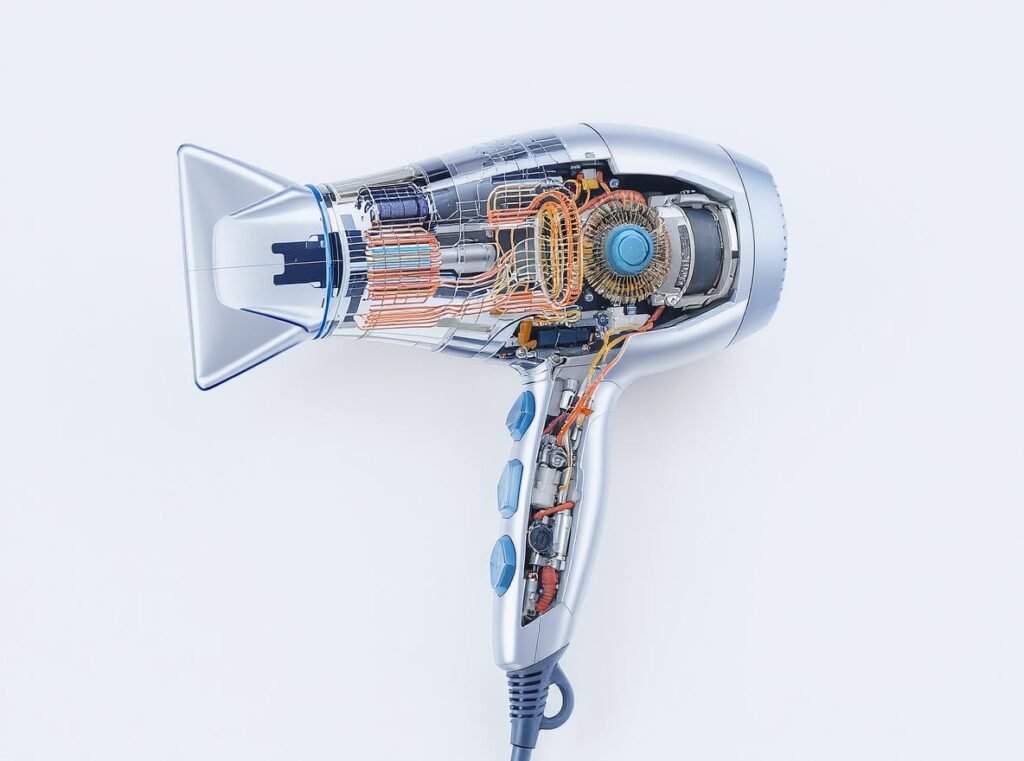
Not all hair dryer features are equally important for winter use. The harsh environmental conditions require specific technologies that work together to protect and style your hair effectively.
Critical Technology Features:
Ionic Technology
Reduces frizz and static by emitting negative ions that help seal the hair cuticle and lock in moisture. This technology is particularly effective for winter when static electricity is a major concern.
Adjustable Heat and Speed Settings
Allows for gentle drying to prevent heat damage, especially important for fragile winter hair. Multiple settings let you customize the drying process based on your hair’s daily condition.
Cool Shot/Cold Air Setting
Helps set styles and reduce heat exposure, minimizing damage and static. This feature is essential for sealing the hair cuticle and preserving moisture after styling.
Infrared Technology
Provides gentle, even heat that penetrates the hair shaft, reducing drying time and heat damage. This technology is particularly beneficial for winter hair that’s already compromised.
Essential Attachments:
| Attachment | Best For | Winter Benefit |
|---|---|---|
| Concentrator Nozzle | Precision styling | Directs airflow to reduce heat concentration |
| Diffuser | Curly/wavy hair | Maintains curl pattern while reducing frizz |
| Wide-tooth Comb | Detangling | Prevents breakage during styling |
Design Considerations:
Lightweight and ergonomic design makes styling easier and more comfortable, especially for longer winter styling sessions when hair takes more time to achieve desired results.
Which Hair Dryer Technologies Work Best for Winter?
Understanding the science behind different hair dryer technologies helps you choose the most effective option for winter hair protection and styling.
The most effective winter hair dryer technologies combine ionic generation for static control, infrared heat for gentle drying, and ceramic elements for even temperature distribution to minimize damage while maximizing styling results.
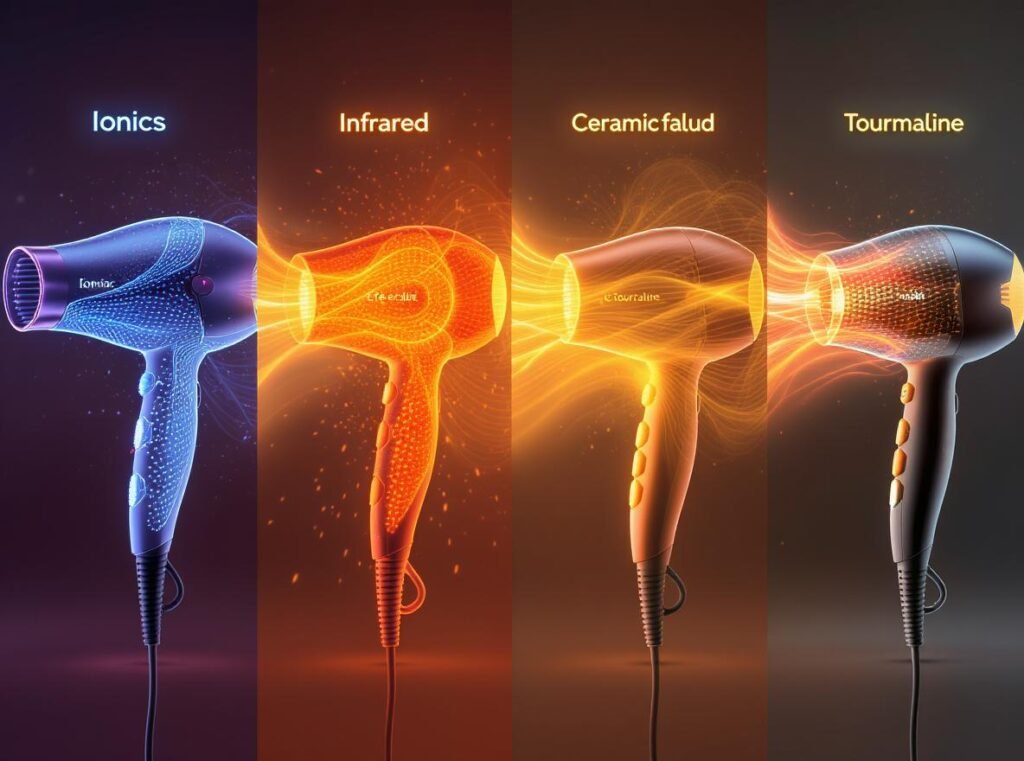
Different technologies address specific winter hair challenges, and the best winter hair dryers combine multiple technologies for comprehensive protection.
Technology Comparison for Winter Use:
| Technology | Winter Benefits | Effectiveness |
|---|---|---|
| Ionic | Reduces frizz/static, speeds drying | Excellent |
| Infrared | Gentle, even heat, less damage | Superior |
| Ceramic | Even heat distribution, good for fine hair | Very Good |
| Tourmaline | Enhances ionic effect, smooths hair | Excellent |
| High-Speed | Fast drying, minimal heat exposure | Superior |
Ionic Technology Deep Dive:
Ionic technology works by breaking down water molecules into smaller particles, allowing for faster evaporation and reduced drying time. The negative ions generated help neutralize the positive charges that cause static electricity, making this technology particularly valuable for winter hair care.
Infrared Technology Advantages:
Infrared heat penetrates the hair shaft from the inside out, providing more even heat distribution and reducing the risk of surface damage. This gentle heating method is ideal for winter hair that’s already compromised by environmental factors.
Ceramic and Tourmaline Enhancement:
Ceramic heating elements provide consistent temperature control, while tourmaline crystals emit additional negative ions and infrared heat. This combination maximizes moisture retention while minimizing damage.
The Conason P1C incorporates these advanced technologies specifically designed for professional results while protecting hair health during harsh winter conditions.
How Do High-Speed Hair Dryers Compare for Winter Use?
High-speed hair dryers have revolutionized winter hair care by dramatically reducing heat exposure time while delivering superior results for compromised hair.
High-speed hair dryers with powerful motors and advanced airflow design minimize heat damage by reducing drying time up to 70%, making them ideal for protecting winter-compromised hair while delivering professional styling results.
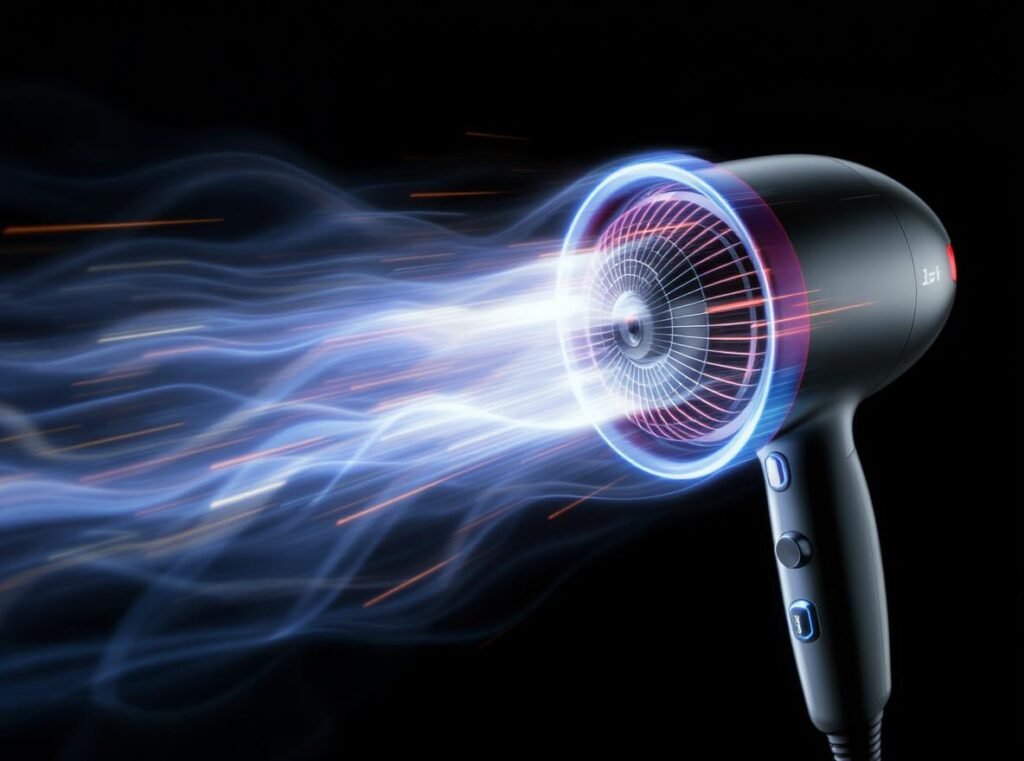
Traditional hair dryers operate at around 20,000 RPM, while high-speed models can reach 100,000+ RPM. This dramatic increase in motor speed creates significantly more powerful airflow that dries hair faster with less heat exposure.
Performance Comparison:
| Dryer Type | Drying Time | Heat Exposure | Static Control | Winter Effectiveness |
|---|---|---|---|---|
| Traditional | 15-20 minutes | High | Poor | Limited |
| Ionic/Ceramic | 10-15 minutes | Medium | Good | Better |
| High-Speed | 5-8 minutes | Low | Excellent | Superior |
High-Speed Winter Advantages:
- Powerful motors provide rapid drying, reducing moisture loss during styling
- Smart temperature controls prevent overheating of already-damaged winter hair
- Advanced ionic technology provides superior static elimination
- Quieter operation and lighter weight improve user experience
- More effective at reducing frizz and static compared to traditional models
Leading High-Speed Options:
High-speed dryers like the Dyson Supersonic and Laifen Swift use intelligent heat control and ionic technology, making them ideal for winter when hair is more vulnerable to damage. These models often include multiple attachments and settings specifically designed for different hair types and conditions.
The combination of speed and advanced technology makes high-speed dryers particularly valuable for winter hair care when time and protection are both priorities.
What About Different Hair Types in Winter?
Winter affects different hair types uniquely, requiring specific hair dryer features and techniques tailored to each hair type’s particular vulnerabilities.
Each hair type faces distinct winter challenges that require targeted hair dryer technologies: thick/frizzy hair needs ionic technology with high wattage, fine hair requires ceramic heating with adjustable settings, and damaged hair benefits from infrared technology with cool shot functions.
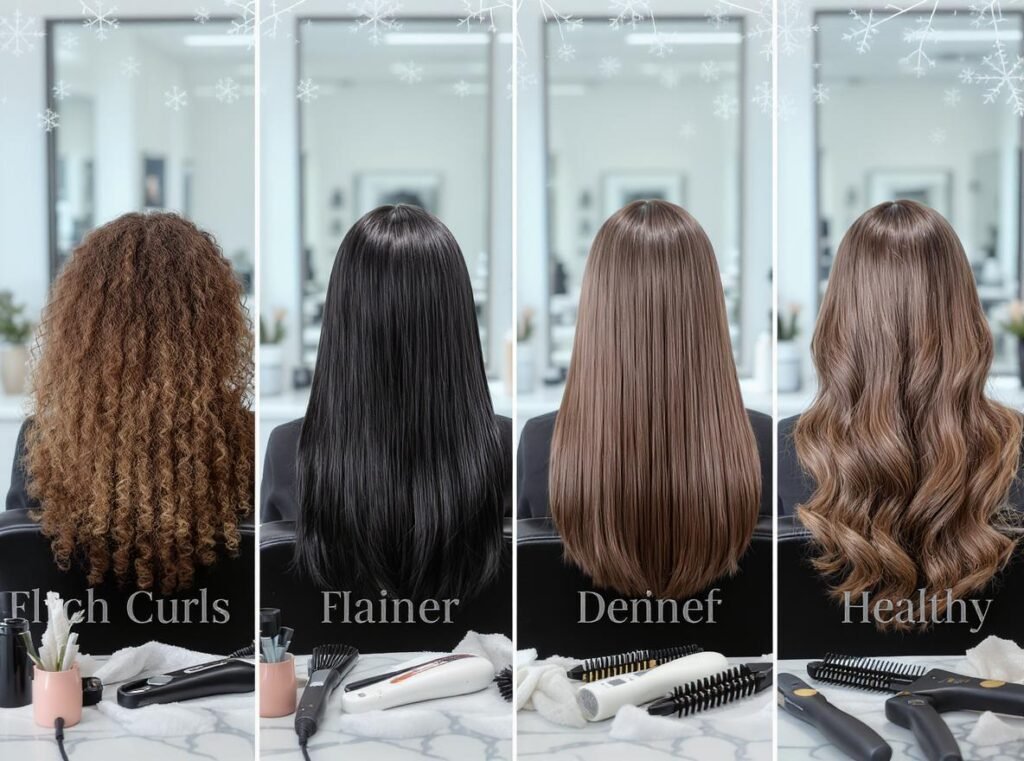
Understanding your hair type’s specific winter needs helps you select the most effective hair dryer features and develop appropriate styling techniques.
Hair Type-Specific Winter Requirements:
| Hair Type | Winter Challenges | Recommended Features |
|---|---|---|
| Thick/Frizzy | Increased frizz, longer drying time | Ionic, high-wattage, diffuser |
| Fine/Thin | Increased fragility, static buildup | Ceramic, adjustable heat, lightweight |
| Curly/Coily | Moisture loss, shape distortion | Diffuser, gentle/infrared heat |
| Damaged/Dry | Extreme fragility, breakage risk | Infrared, ionic, cool shot |
Thick and Frizzy Hair Winter Care:
Thick hair becomes more challenging to manage in winter as it takes longer to dry, increasing heat exposure risk. These hair types benefit from:
- High-wattage dryers (1,800+ watts) for efficient drying
- Ionic technology to combat increased frizz
- Diffuser attachments for even air distribution
- Multiple speed settings for customized control
Fine and Thin Hair Protection:
Fine hair becomes more fragile in winter weather and requires gentle treatment:
- Lower wattage (1,500 watts or less) to prevent damage
- Ceramic heating for even temperature distribution
- Lightweight design for comfortable handling
- Concentrator nozzles for precise styling without over-processing
Curly and Coily Hair Maintenance:
Curly hair is naturally more porous and prone to winter damage:
- Diffuser attachments to maintain natural curl pattern
- Infrared technology for gentle heat penetration
- Multiple heat settings for customized care
- Ionic technology for moisture retention
Damaged and Chemically-Treated Hair:
Hair that’s already compromised needs maximum protection:
- Infrared heat technology for the gentlest drying
- Cool shot function to seal cuticles and reduce damage
- Ionic technology to add moisture and reduce static
- Temperature control for precise heat management
Are Professional Hair Dryers Worth It for Winter?
Professional-grade hair dryers offer superior winter hair protection through advanced technologies and build quality that consumer models often cannot match.
Professional hair dryers are worth the investment for winter use because they provide faster drying with less heat damage, advanced technologies like ionic and infrared heating, multiple attachments for all hair types, and superior durability for regular use.
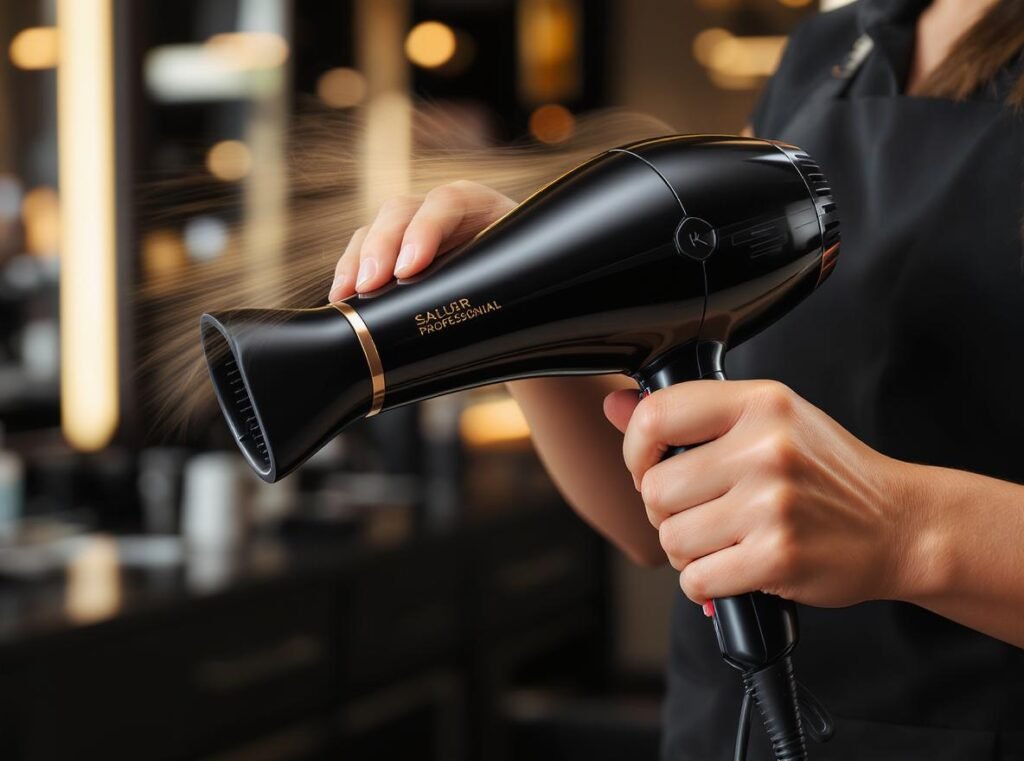
The difference between consumer and professional hair dryers becomes most apparent during winter months when your hair needs maximum protection and care.
Professional Advantages for Winter:
- Faster drying reduces time hair is exposed to environmental damage
- Advanced technologies (ionic, infrared, smart sensors) provide superior protection
- Multiple attachments accommodate different hair types and styling needs
- Ergonomic design supports comfortable use during longer styling sessions
- Professional-grade motors provide consistent performance and longevity
Investment Considerations:
Professional dryers typically cost 2-3 times more than consumer models, but they offer:
- 3-5 times longer lifespan with proper maintenance
- Better heat distribution and temperature control
- More effective static and frizz reduction
- Faster drying times that reduce overall heat exposure
- Comprehensive warranty and service support
Top Professional Winter Models:
- Dyson Supersonic/Nural: Fast drying, intelligent heat control, multiple attachments for all hair types
- BaBylissPRO Nano Titanium: Excellent for thick or hard-to-dry hair with powerful airflow and ionic technology
- GHD Helios: Lightweight, powerful, and effective at reducing frizz and static
For businesses serving clients with winter-damaged hair, professional dryers provide the reliability and results necessary for customer satisfaction and repeat business.
How Should You Use Your Hair Dryer in Winter?
Proper winter hair dryer technique becomes even more critical when your hair is already compromised by environmental factors and needs maximum protection.
Winter hair dryer technique focuses on using heat protectant products, rough drying to 50-75% before styling, keeping the dryer moving to prevent hot spots, and finishing with cool shot to seal cuticles and reduce static.
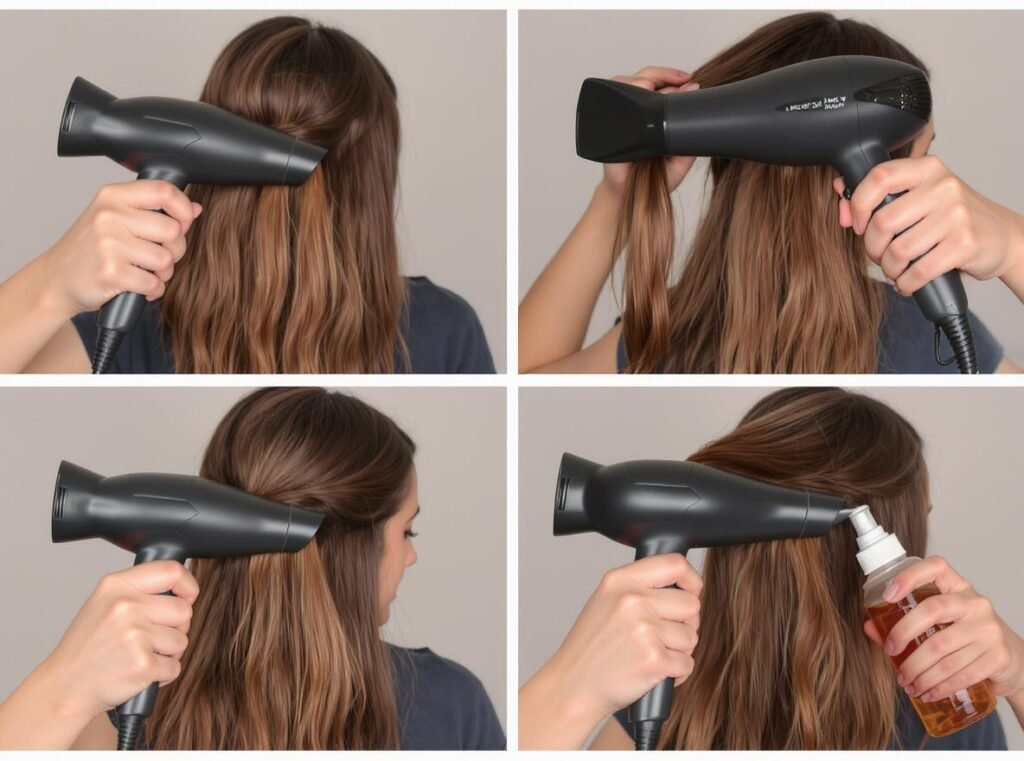
The combination of proper products and correct technique maximizes your hair dryer’s winter effectiveness while minimizing potential damage.
Pre-Drying Preparation:
Always use a heat protectant spray to shield hair from heat damage before any thermal styling. This step becomes crucial in winter when hair is already vulnerable to environmental damage.
Apply leave-in conditioners for extra moisture protection, and gently towel-dry hair to remove excess water without causing friction damage.
Optimal Winter Drying Technique:
- Rough dry hair to 50-75% before detailed styling to minimize total heat exposure
- Use lower heat settings than you would in summer months
- Keep the dryer moving continuously to prevent hot spots and concentrated heat damage
- Maintain 6-8 inches distance from scalp to prevent overheating
- Section hair systematically for even drying and reduced frizz
- Use appropriate attachments – concentrator nozzles for smoothness, diffusers for curls
Finishing Techniques:
- Finish with cool shot to set the style and reduce static buildup
- Avoid excessive heat – opt for lower settings and increase airflow instead
- Allow each section to cool before moving to the next area
Professional Tips:
- Work from roots to ends for best moisture distribution
- Use a brush to smooth each section as you dry
- Pay extra attention to ends, which are most vulnerable to winter damage
This systematic approach ensures thorough drying while minimizing winter-specific hair damage.
Which Hair Dryer Brands Excel in Winter Performance?
Certain manufacturers have developed technologies specifically addressing winter hair care challenges, making them superior choices for cold-weather hair health and styling.
Leading hair dryer brands for winter performance include Dyson for intelligent heat control, BaBylissPRO for powerful ionic technology, GHD for advanced frizz reduction, T3 for ion-rich airflow, and Conason for professional-grade high-speed performance.
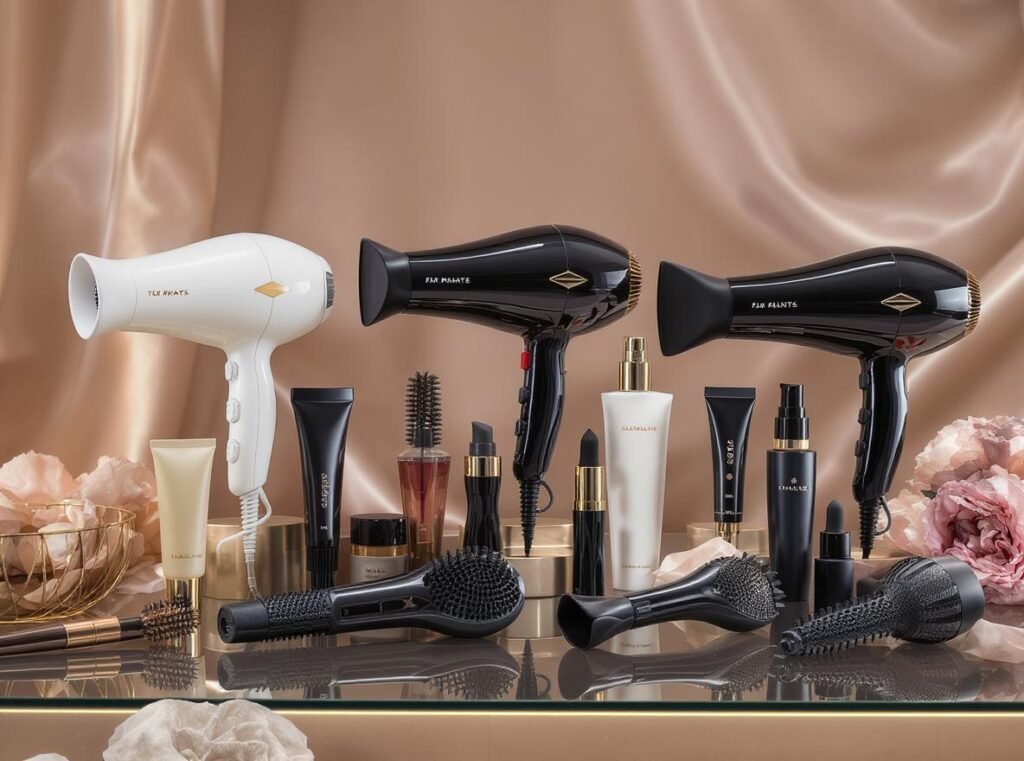
The hair dryer market offers numerous options, but winter hair care requires specific technological capabilities that only certain brands provide effectively.
Top Brand Technologies for Winter:
Dyson (Supersonic/Nural):
- Fast drying with intelligent heat control prevents overheating
- Multiple attachments accommodate all hair types
- Advanced airflow engineering reduces drying time
- Excellent for professional and home use
BaBylissPRO (Nano Titanium):
- Powerful ionic technology for thick, frizzy hair
- Professional-grade performance and durability
- Excellent heat distribution for consistent results
- Ideal for salon environments
GHD (Helios/Air):
- Advanced ionic technology for superior frizz control
- Lightweight design for comfortable extended use
- Effective static reduction for winter conditions
- Professional styling results
T3 (AireLuxe/Aire IQ):
- Ion-rich airflow for enhanced moisture retention
- Rapid drying with gentle heat protection
- Multiple settings for customized care
- Excellent for damaged or fragile hair
Conason (P1C):
- High-speed motor technology for rapid drying
- Negative ionic technology for static elimination
- Professional-grade build quality
- Ideal for wholesale and retail markets
Key Differentiators:
- Motor power and longevity for consistent performance
- Heat distribution technology for even temperature
- Ionic generation capacity for static control
- Attachment variety and quality for versatility
- Temperature control precision for hair protection
What’s the Best Hair Dryer for Professional Winter Use?
Professional stylists and salons need hair dryers that can handle winter-damaged hair while delivering consistent, high-quality results for demanding clients throughout the harsh winter months.
The best professional hair dryers for winter use combine high-speed motor technology with advanced ionic systems, multiple heat settings, and comprehensive attachment sets, with the Conason P1C offering exceptional performance specifically designed for professional winter hair care challenges.
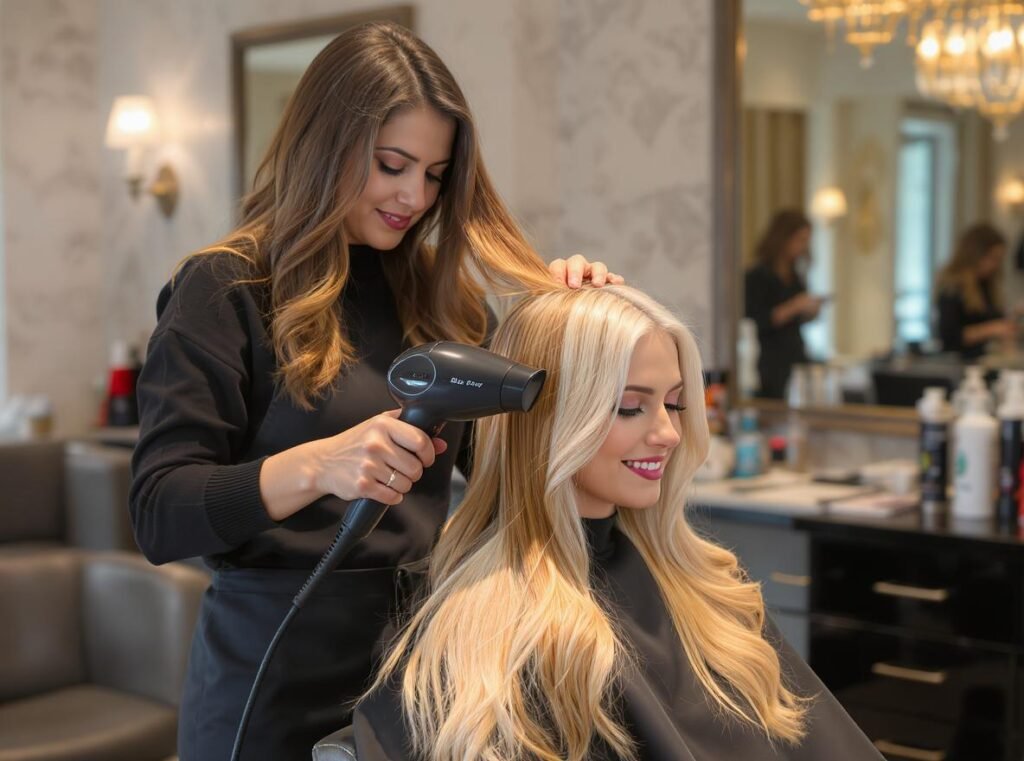
Professional winter hair care requires equipment that can handle the increased challenges of cold-weather damaged hair while maintaining efficiency and results quality across diverse client needs.
Professional Winter Requirements:
- Consistent performance across all hair types and conditions
- Fast drying times to minimize heat exposure for damaged hair
- Effective static elimination for winter-specific problems
- Durable construction for daily salon use
- Ergonomic design for comfortable extended styling sessions
Why Professional Dryers Excel in Winter:
Professional dryers offer superior motor technology, advanced heating elements, and protective features that justify the investment for serious hair care professionals dealing with winter-damaged hair.
Conason P1C Professional Advantages:
The P1C combines high-speed motor technology with advanced ionic systems, making it ideal for professional winter hair care:
- Negative ionic technology eliminates static electricity common in winter
- Multiple heat and speed settings allow customization for winter-damaged hair
- Ceramic heating elements provide even temperature distribution
- Professional-grade attachments offer versatility for all hair types
- Ergonomic design supports comfortable extended use in salon environments
- High-speed motor reduces drying time and heat exposure
Professional Performance Benefits:
- Faster client turnover due to reduced drying time
- Better results on winter-damaged hair
- Reduced client discomfort from static and frizz
- Consistent performance across busy salon days
- Professional reputation enhancement through superior results
For Wholesale Partners:
The Conason P1C represents an excellent addition to professional product lines, offering the advanced technology that stylists need for winter hair care success while providing retailers with a competitive advantage in the professional market.
Summary
Winter hair care requires specialized hair dryer features to combat the season’s harsh effects including dryness, static, and increased fragility. The best winter hair dryers combine ionic technology for static control, ceramic or infrared heating for gentle temperature distribution, adjustable settings for damaged hair protection, and cool shot functions for cuticle sealing. High-speed dryers with negative ion generation, like the Conason P1C, provide superior protection against winter’s drying effects while delivering professional results through advanced motor technology and comprehensive styling attachments.
Ready to upgrade your winter hair care routine with professional-grade technology? Explore our complete collection of high-performance hair dryers designed for optimal winter protection and styling results. Visit our product collection to discover the perfect solution for your hair type and styling needs, or learn more about the Conason P1C and how its advanced winter-specific features can transform your hair care results. Contact us today for wholesale inquiries, professional pricing, and technical specifications.

